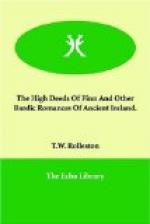This could not have been done in the right way if it had not been for the previous work of Celtic scholars in Ireland, and particularly on the Continent, in France and Germany. Having mastered medieval Irish, they have translated with careful accuracy many of the ancient tales, omitting and changing nothing; they have edited them critically, collating and comparing them with one another, and with other forms of the same stories. We have now in English, French, and German the exact representation of the originals with exhaustive commentaries.
When this necessary work was finished—and it was absolutely necessary—it had two important results on all work of the kind Mr Rolleston has performed in this book—on the imaginative recasting and modernizing of the ancient tales. First, it made it lawful and easy for the modern artist—in sculpture, painting, poetry, or imaginative prose—to use the stories as he pleased in order to give pleasure to the modern world. It made it lawful because he could reply to those who objected that what he produced was not the real thing—“The real thing exists; you will find it, when you wish to see it, accurately and closely translated by critical and competent scholars. I refer you to the originals in the notes to this book. I have found the materials of my stories in these originals; and it is quite lawful for me, now that they have been reverently preserved, to use them as I please for the purpose of giving pleasure to the modern world—to make out of them fresh imaginative work, as the medieval writers did out of the original stories of Arthur and his men.” This is the defence any re-caster of the ancient tales might make of the lawfulness of his work, and it is a just defence; having, above all, this use—that it leaves the imagination of the modern artist free, yet within recognized and ruling limits, to play in and around his subject.
One of those limits is the preservation, in any remodelling of the tales, of the Celtic atmosphere. To tell the Irish stories in the manner of Homer or Apuleius, in the manner of the Norse sagas, or in the manner of Malory, would be to lose their very nature, their soul, their nationality. We should no longer understand the men and women who fought and loved in Ireland, and whose characters were moulded by Irish surroundings, customs, thoughts, and passions. We should not see or feel the landscape of Ireland or its skies, the streams, the woods, the animals and birds, the mountain solitudes, as we feel and see them in the original tales. We should not hear, as we hear in their first form, the stormy seas between Scotland and Antrim, or the great waves which roar on the western isles, and beat on cliffs which still belong to another world than ours. The genius of Ireland would desert our work.
And it would be a vast pity to lose the Irish atmosphere in the telling of the Irish tales, because it is unique; not only distinct from that of the stories of other races, but from that of the other branches of the Celtic race. It differs from the atmosphere of the stories of Wales, of Brittany, of the Highlands and islands of Scotland. It is more purely Celtic, less mixed than any of them. A hundred touches in feeling, in ways of thought, in sensitiveness to beauty, in war and voyaging, and in ideals of life, separate it from that of the other Celtic races.




